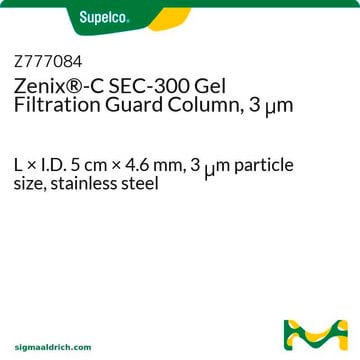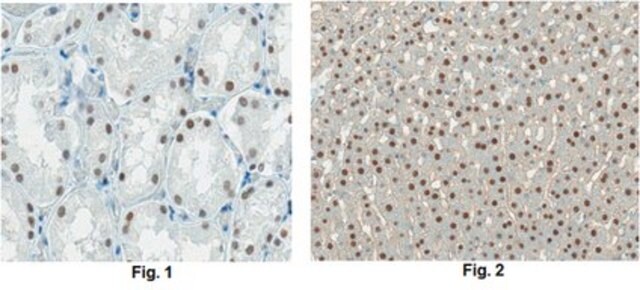Yes. Ascentis Express columns are packed in a way making them suitable for these ultra high pressure instruments. In fact, Ascentis Express outperforms sub-2 μm micron columns on many applications since Ascentis Express provides the benefits of sub-2 μm particles but at much lower back pressure. These benefits include the capability of providing fast HPLC and higher resolution chromatography. The Fused-Core particle consists of a 1.7 μm solid core and a 0.5 μm porous shell. A major benefit of the Fused-Core particle is the small diffusion path (0.5 μm) compared to conventional fully porous particles. The shorter diffusion path reduces axial dispersion of solutes and minimizes peak broadening.
Wichtige Dokumente
53938-U
Ascentis® Express 90 Å HILIC (2.7 μm) HPLC Columns
L × I.D. 7.5 cm × 2.1 mm, HPLC Column
About This Item
Empfohlene Produkte
Produktbezeichnung
Ascentis® Express HILIC HPLC Column, 2.7 μm particle size, L × I.D. 7.5 cm × 2.1 mm
Materialien
stainless steel column
Agentur
suitable for USP L3
Produktlinie
Ascentis®
Leistungsmerkmale
endcapped: no
Hersteller/Markenname
Ascentis®
Verpackung
1 ea of
Parameter
≤100 °C temp. range
600 bar max. pressure (9000 psi)
Methode(n)
HPLC: suitable
LC/MS: suitable
UHPLC-MS: suitable
UHPLC: suitable
L × ID
7.5 cm × 2.1 mm
Oberflächenbereich
135 m2/g
Verunreinigungen
<5 ppm metals
Matrix
Fused-Core particle platform
superficially porous particle
Aktive Matrixgruppe
silica phase
Partikelgröße
2.7 μm
Porengröße
90 Å
Betriebs-pH-Wert
1-8
Anwendung(en)
food and beverages
Trenntechnik
hydrophilic interaction (HILIC)
normal phase
Suchen Sie nach ähnlichen Produkten? Aufrufen Leitfaden zum Produktvergleich
Verwandte Kategorien
Allgemeine Beschreibung
Visit the Ascentis Express home page for more information on this new column technology.
Rechtliche Hinweise
Erforderlich, aber nicht bereitgestellt
Vorsäulenkartusche
Ähnliches Produkt
Lagerklassenschlüssel
11 - Combustible Solids
WGK
WGK 3
Flammpunkt (°F)
Not applicable
Flammpunkt (°C)
Not applicable
Hier finden Sie alle aktuellen Versionen:
Analysenzertifikate (COA)
Die passende Version wird nicht angezeigt?
Wenn Sie eine bestimmte Version benötigen, können Sie anhand der Lot- oder Chargennummer nach einem spezifischen Zertifikat suchen.
Besitzen Sie dieses Produkt bereits?
In der Dokumentenbibliothek finden Sie die Dokumentation zu den Produkten, die Sie kürzlich erworben haben.
Artikel
For separation of polar compounds including polar neutrals, polar acids, and polar and non-polar basic amines use our Ascentis® Express HILIC column.
Protokolle
We offer the tools for the analysis of the metabolites; including certified reference standards, enzymes, substrates, and chromatographic products.
-
Can I use Ascentis Express on a UHPLC system?
1 Antwort-
Hilfreich?
-
-
Would you advise addition of a buffer when using diol or amide stationary phase?
1 Antwort-
Yes. if possible you should always have at least a small amount of buffer in a HILIC system to help mediate/control IEX and other polar interactions that are bound to be present (even if at a low level). It is not so much the "buffering capacity" that is important, but the presence of the competing ions. We have found that their presence helps with day to day and column to column reproducibility. There are times when you need to eliminate the buffer, but aside from special circumstances, our recommendation is to include them.
Hilfreich?
-
-
When referring to the pH of the mobile phase (pH 3, pH 4, etc.), does that refer to the aqueous part of the mobile phase?
1 Antwort-
Typically when we refer to pH in HILIC, we use the effective pH or the pH as measured after the addition of organic. The point is that we should always define what pH we are stating. The common way to distinguish is using notation of w/w pH or s/w pH (usually superscript/subscript). The notations mean superscript = solvent the pH is measured in (s would indicate some mixture of aqueous:organic) and the subscript = the solvent the pH meter is calibrated in (typically water (or w) as we readily have calibration standards).
Hilfreich?
-
-
How should I store the Ascentis Express HILIC column?
1 Antwort-
Long-term storage of silica-based columns is best in 100% acetonitrile. Columns may be safely stored for short periods (up to 3 or 4 days) in most common mobile phases. However, when using buffers, it is best to remove the salts to protect both the column and the HPLC equipment by first flushing the column with the same mobile phase without the buffer (e.g., when using 90/10 ACN/buffer, flush the column with 90/10 ACN/H2O) to eliminate any concern about salt precipitation or corrosion from the salts then flush the column with 100% acetonitrile for storage.Before storing the column, the end-fittings should be tightly sealed with the endplugs that came with the column to prevent the packing from drying.
Hilfreich?
-
-
Can I use Ascentis Express on any type of HPLC system?
1 Antwort-
Ascentis Express HPLC columns are capable of use on standard HPLC systems as well as UHPLC systems. Columns are packed in high pressure hardware capable of withstanding the pressures used in UHPLC systems.
Hilfreich?
-
-
Can Ascentis® Express HPLC Columns be used for LC-MS?
1 Antwort-
Express Fused-Core™ particles were designed with LC-MS in mind. Even extremely short column lengths exhibit sufficient plate counts to show high resolving power. The flat van Deemter plots permit resolution to be maintained at very high flow rates to maximize sample throughput. All Ascentis stationary phases have been evaluated for MS compatibility during their development, and the Express phases are no exception. You can expect extremely low column bleed and background while maintaining longest possible column lifetime. A bonus of Ascentis Express columns for high throughput UHPLC and LC-MS is that they are extremely rugged and highly resistant to plugging, a very common failure mode for competitor columns.
Hilfreich?
-
-
How does the flow rate influence the water layer on the column?
1 Antwort-
We are not aware of any systematic studies with respect to the impact of flow rate on HILIC separations. Our concern would be that as you move to higher flow rates, you might observe peak shape issues due to the slow kinetics of IEX and adsorption mechanisms. If the retention mechanisms for a given system are partition dominated, this should be of less concern. It will be a case by case cause and effect.
Hilfreich?
-
-
What flow rate should I use with Ascentis® Express HPLC Columns?
1 Antwort-
Based on the minimum in the van Deemter curves, higher flows than 5um particle columns are required in order to maximize Ascentis Express column efficiency. The suggested starting point for flow rate for Ascentis Express columns: 1.6 mL/min for 4.6 mm ID; 0.8 mL/min for 3.0 mm ID; and 0.4mL/min for 2.1 mm ID.
Hilfreich?
-
-
In HILIC separations, what happens if the sample is an aqueous matrix? Does it always have a negative effect?
1 Antwort-
Yes, it would be highly preferential (especially in this case where you want partitioning to dominate) to inject in high organic. That said, you can 'get away' with it if the injection volume can be kept small - much like we can inject low volumes of stronger solvents in RP mode, if needed. What you will want to do to minimize impact is to get as much retention on the analytes of interest as you can, this helps give the sample solvent some time to dissipate and negate the effects.
Hilfreich?
-
-
Can peptide or protein samples be analyzed using HILIC columns?
1 Antwort-
Polar peptides are quite amenable to HILIC separations; however, our experience with larger peptides has been only minimally successful - mainly due to solubility issues. Proteins are even more difficult due to the same issue. An additional problem with proteins is that they are often multiply charged. When IEX is performed on multiply charged analytes, you often get what is referred to as a rolling effect where the analyte interacts with ionic sites on the surface in many different ways as it 'rolls' down the column; this produces broad and misshapen peaks.
Hilfreich?
-
Aktive Filter
Unser Team von Wissenschaftlern verfügt über Erfahrung in allen Forschungsbereichen einschließlich Life Science, Materialwissenschaften, chemischer Synthese, Chromatographie, Analytik und vielen mehr..
Setzen Sie sich mit dem technischen Dienst in Verbindung.







